
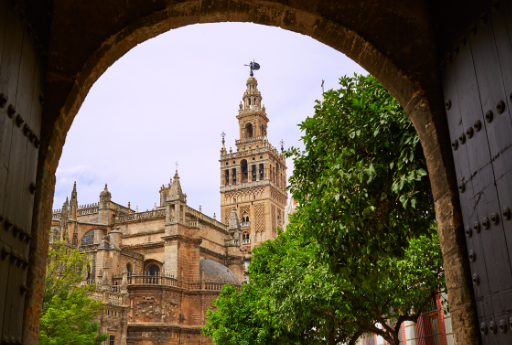
Cathedral and Giralda
The Cathedral of Santa María de la Sede is located in the historic center of Seville. It is in the gothic style, being the largest in the world. Unesco declared it in 1987, next to the Real Alcázar and the Archivo de Indias, World Heritage Site and, the 25 July 2010, Asset of Outstanding Universal Value. According to the tradition, construction started in 1401, although there is no documentary evidence of the beginning of the works until 1433. The building was carried out on the site that remained after the demolition of the old Aljama Mosque in Seville,Whose minaret (the Giralda) and patio (Courtyard of the Orange trees) they are still preserved.
It is the name given to the bell tower of the Cathedral of Santa María de la Sede, from the city of Seville. The two lower thirds of the tower correspond to the minaret of the old mosque of the city, late 12th century, in the Almohad period, while the upper third is a superimposed construction in Christian times to house the bells. At its top there is a ball called a jar on which stands the bronze statue that represents the Triumph of Faith and that has the function of a weather vane., the Giraldillo, initially called Giralda, until the town gave this name to the whole tower. The Giralda measures 104,1 meters high, including the Giraldillo. It was for centuries the tallest tower in Spain, as well as one of the highest constructions. The 29 from December to 1928 was declared National Heritage and in 1987 joined the list of World Heritage Sites.
Direction: Avda. of the Constitution, 41004 Sevilla
Schedule: Monday to Sunday from 8.00 a 14.00 h, and of 16.00 a 19.00 h. It is recommended to go with advance entry.
Phone: 902099692

Real Alcázar of Seville
The Alcázar of Seville has always been used as the accommodation of kings and high personalities. It is made up of various buildings from different eras. The original fortification was built on an old Roman and later Visigothic settlement. Later it became an early Christian basilica (Saint Vincent Martyr). The Real Alcázar of Seville begins to take its current appearance after the taking of the city by the Arabs in the year 713. One of the palaces that surrounds two courtyards is from the same period as the Alhambra in Granada. Declared a World Heritage Site by UNESCO, the Real Alcazar, It has also been the scene of several productions such as The Kingdom of Heaven, Alatriste o JGame of Thrones.
Direction: Patio de Banderas, 41004 Sevilla
Schedule:
– 01/10 – 31/03: Monday to Sunday, and holidays of 9.30 a 17.00 h
– 01/04 – 30/09: Monday to Sunday, and holidays of 9.30 a 19.00 h
Phone: 954502324
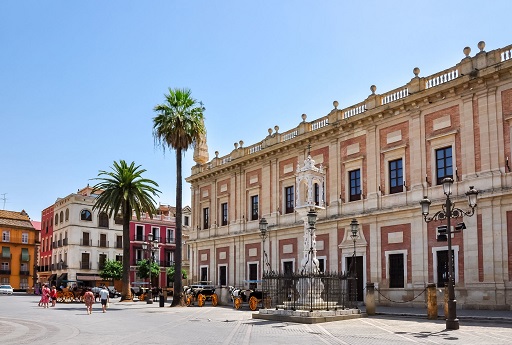
General Archive of the Indies
The General Archive of the Indies of Seville was created in 1785 at the wish of King Carlos III, with the aim of centralizing in a single place the documentation referring to the administration of the Spanish overseas territories until then dispersed in various files: Simancas, Cadiz and Seville. Actually, the file keeps a few 43 000 files, with some 80 million pages and 8 000 maps and drawings that proceed, fundamentally, of the agencies responsible for the administration of overseas territories. It was declared a World Heritage Site by Unesco in 1987, next to the Cathedral and the Real Alcázar.
Direction: Avda. of the Constitution, 41004 Sevilla
Schedule: Monday to Saturday from 9.30 a 17.00 h, and Sundays of 10.00 a 14.00 h
Phone: 954500528
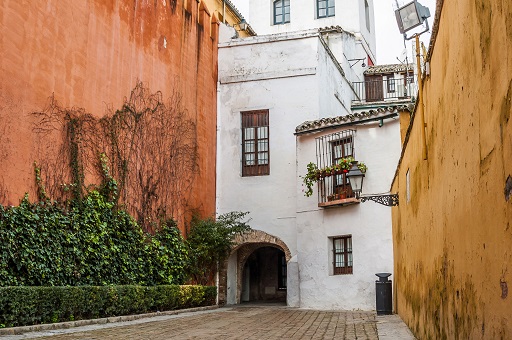
Walls and Barrio de Santa Cruz
The city of Híspalis, Roman Seville, found in this area its walled limits on its eastern side, by the area of the door of the meat, Y, on its southern side, around the Plaza del Triunfo area. The thistle (or great roman way) then passed through the current streets Abades and Don Remondo. Next to the cardus there was a second century temple of which three columns of the portico are preserved in the same place, on Marmoles street. In the Middle Ages six columns were preserved in that same place.
Within the neighborhood you can visit the Murillo Gardens, a green area next to the wall, attached to the Catalina de Ribera walk, which is also landscaped. They were classified as Asset of Cultural Interest in 2002. Between the seventeenth and nineteenth centuries it was the church of the convent of the Holy Spirit, of the minor clergy. It is located in Mateos Gago street and has another access through the Plaza de la Escuela de Cristo. It is the headquarters of the Brotherhood of Santa Cruz.
Direction: starts in Plaza Patio de Banderas 3, 41004 Sevilla
Schedule: We recommend reserving guided tours of Barrio de Santa Cruz in advance to reserve the place.
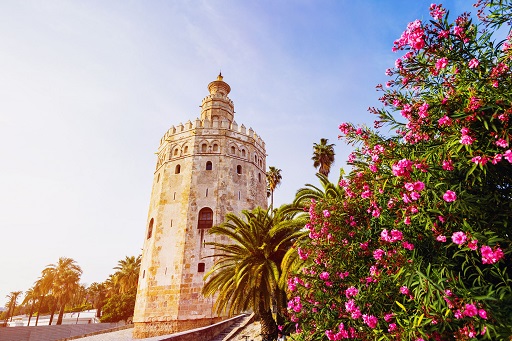
Torre del Oro
The Torre del Oro in Seville is an albarrana tower located on the left bank of the Guadalquivir river, next to the Maestranza bullring. Its height is 36 meters and was declared a historical-artistic monument in 1931 and has been restored several times. In the Contemporary Age it was restored in 1900, Come in 1991 Y 1992, in 1995 and in 2005. The work of the Navy has been important in its conservation. It is in good condition and houses the Naval Museum of Seville.
Direction: Paseo de Cristóbal Colón, 41001 Sevilla
Schedule: Monday to Friday of 9.30 a 18.45 h, Saturdays and Sundays of 10.30 a 18.45 h.
Phone: 954222419
We recommend checking the ticket price and booking in advance.

Maria Luisa Park
They are one of the best known and most loved gardens in the city. They were donated to the Sevillians by María Luisa Fernanda de Borbón in 1914. A detour in its central avenue leads to a statue of Bécquer, paid for by the Álvarez Quintero brothers. It is totally recommended to get lost in its labyrinthine paths, ponds, fountains and abundant vegetation.
Direction: Paseo de las Delicias s/n, 41013 Sevilla
Schedule: Monday to Sunday from 8.00 a 22.00 h

Spain Square
It is the most famous square in Seville, and in it are the names of all the provinces of Spain. It was projected for the Ibero-American Exhibition of 1929 by the architect Aníbal González, and currently maintains all the gallantry and the romantic halo, that have made it an absolutely unique space. In it you can enjoy a boat ride or ideal waffle stands.
Direction: Avda. Isabel la Católica s/n, 41004 Sevilla
Schedule: has no predetermined schedule

Museum of Bellas Artes
It is the most relevant museum in Seville, and the second art gallery in Spain, where a valuable collection of painting from the baroque school is preserved, in addition to other large-scale exhibitions. For residents of the European Union, entrance is free, and on Sundays there is usually a market in the Plaza del Museo.
Direction: Museum Square 9, 41001 Sevilla
Schedule: Monday to Saturday from 9.00 a 21.00 h, and Sundays of 9.00 a 15.00 h.
Phone: 955542942
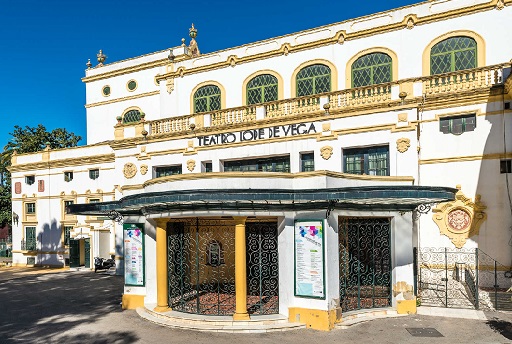
Lope de Vega Theater and Exhibition Casino
The Lope de Vega Theater, It is located in a neo-baroque building in 1929. Inside the theater itself, there is a "Great Hall of Parties", with multiple dependencies, known as Casino de la Exposición. They were built to be the Seville Pavilion at the Ibero-American Exhibition.
Direction: Avda. María Luisa s / n, 41013 Sevilla
Schedule: we recommend consulting their website for visits or tickets
http://teatrolopedevega.org/contacto/
Phone: 955472828
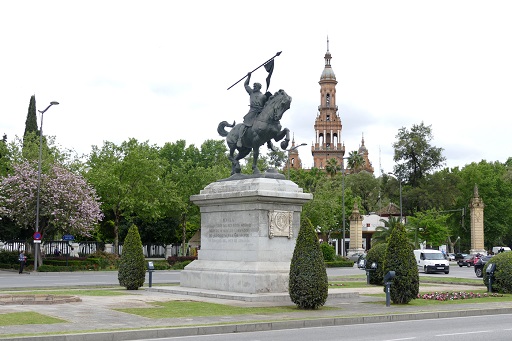
Prado de San Sebastián
It is a large space that was used as a burner for the Inquisition, and in him died the last burned at the stake, the so-called beata Dolores, in 1781. The Seville April Fair was located in the area, since its creation in 1847 until the year 1973 in which it was transferred to the new venue in Los Remedios, since the Prado de San Sebastián space had become too small. In the area there is one of the two bus stations that the city has.
Direction: Prado de San Sebastián, 41004 Sevilla
Schedule: Opened 24 hours
Phone: 955479290
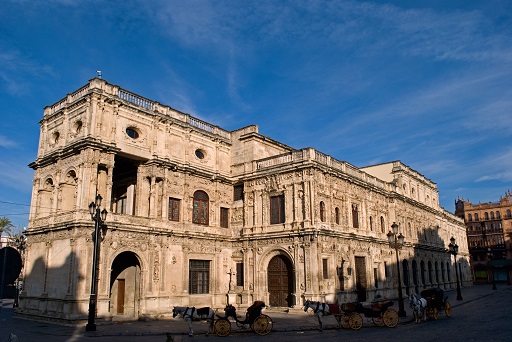
Plaza Nueva and Town Hall
Plaza Nueva is located in the heart of Seville, a few steps from the Avenida de la Constitución, and in it is located the main entrance of the Seville City Council. The historic building that occupies the Town Hall constitutes one of the most notable examples of Renaissance architecture. Construction began in the 16th century by Diego de Riaño, the master executed the southern sector of the City Hall, a small building with only the Chapter House, the halt, the ancient staircase and the Hall of Faithful Executors.
Direction: Plaza Nueva 1, 41001 Sevilla
Town hall schedule: Monday to Thursday from 9.00 a 14.00 and of 16.00 a 18.00 h, Friday of 9.00 a 14.00 h - other days closed
Phone: 955010010
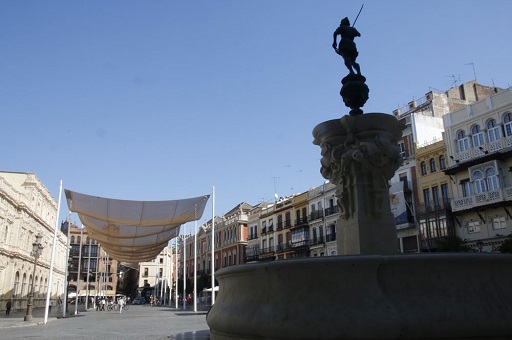
San Francisco Square
This square is located in the Old Town District of Seville. This space was already a square when the Christians reconquered the city in 1248. The name is due to the fact that between 1268 Y 1840 you accessed from this square to the convent of San Francisco. In it, the different Christmas performances and events have been carried out in recent years., being also where the Christmas tree is placed.
Direction: San Francisco Square, 41001 Sevilla
Schedule: opened 24 hours

Real Maestranza de Caballería de Sevilla
Baroque style, the Maestranza bullring is located in the Arenal neighborhood of Seville. It was built in the seventeenth century and is currently owned by the Real Maestranza de Caballería de Sevilla. The Bullfighting Museum is located inside the building that was inaugurated in 1989. In 2008 Princes Felipe de Borbón and Leticia Ortiz inaugurated new rooms, where are they also, 18th century paintings, XIX and XX, bullfighting posters, bullfighting costumes, bronzes, tiles and sculptures.
Direction: Paseo de Cristóbal Colón 12, 41001 Sevilla
Schedule: Check the opening hours and prices of the tickets on the telephone number provided
Phone: 954224577
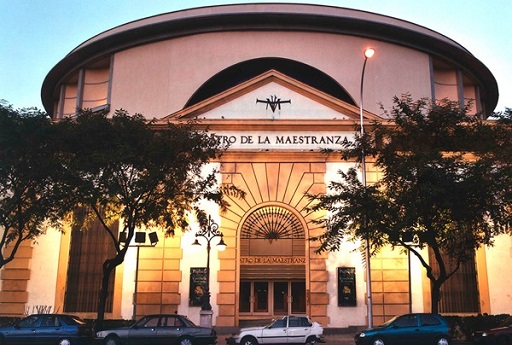
Maestranza Theater
The Teatro de la Maestranza in Seville is the work of the architects Aurelio del Pozo and Luis Marín. It was inaugurated in 1991 and is located next to the Torre del Oro and the Real Maestranza bullring, near the Guadalquivir river. Events such as the proclamation of each year of Holy Week are held there, the delivery of Medals of Andalusia, or specific events such as the awards ceremony of the European Film Academy in 2018.
Direction: Paseo de Cristóbal Colon 22, 41001 Sevilla
Schedule: We recommend visiting their website for visits and tickets
https://www.teatrodelamaestranza.es/contacto.html
Phone: 954223344
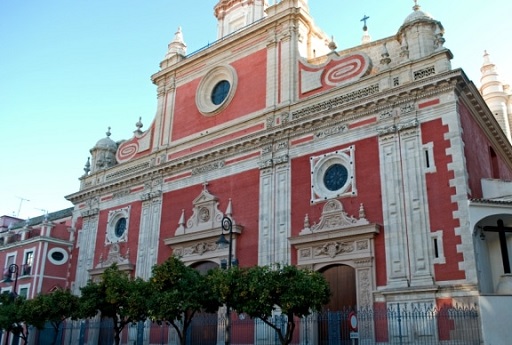
Church of El Salvador
The Collegiate Church of the Divine Savior is a Catholic temple located in the old town of Seville. The current building was completed at the beginning of the 18th century. It is a baroque church and its interior is designed as a large rectangular room. There are pillars with endorsed columns supporting high vaults, becoming the only church in the region with these characteristics.
Direction: Salvador Square 3, 41004 Sevilla
Schedule: Monday to Saturday from 11.00 a 17.30 h, and Sundays of 15.00 a 19.00 h.
Phone: 954211679

Plaza of La Encarnación
The mushrooms of Seville, also known as Metropol Parasol, It is a work of the architect Jürgen Mayer, constitutes the largest wooden structure in the world. The monument contains five levels: on the first level is the Antiquarium or Archaeological Museum, the Official Store Mushrooms of Seville, a Tourist Information Point of the city next to Past View and access to the elevators; on the second level we find the market and restaurants; In the third, an elevated plaza for the enjoyment of citizens; on the fourth level we find the start of the visit to the catwalks, as well as a small bar and an event area of 500 square meter. By last, on the fifth level, we found the viewpoint a 28.5 meters high.
Direction: Plaza de la Encarnación s / n, 41003 Sevilla
Schedule: Monday to Sunday from 9.30 a 22.30 h.
Phone: 606635214
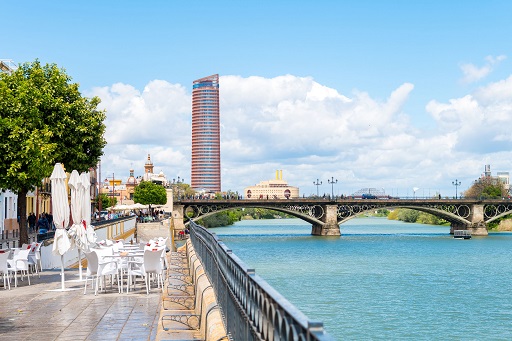
Triana neighborhood
The Triana neighborhood is located on the east bank of the Guadalquivir River, separated from the old town by the Triana Bridge, the San Telmo Bridge and the Cristo de la Expiración Bridge. It is perfect to walk through its endless streets, where it is among others, the Chapel of the Sailors, the Triana Market, the Plaza del Altozano or the Paseo de Nuestra Señora de la O. On Betis street, next to the river, more restaurants can be found, as well as bars and flamenco tablaos. Around the Centro Cerámica Triana museum there are many shops that offer this type of craft.
Direction: Triana, 41010 Sevilla
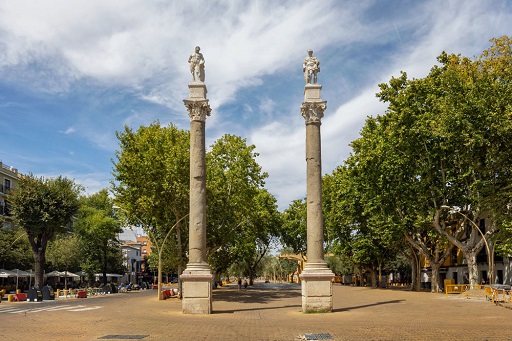
Alameda de Hércules
It is one of the places that escapes the Sevillian character, suggestive alternative scene of the city due to its greater diversity, and urban culture, a bohemian air that makes this space a different offer of leisure and enjoyment. The Alameda de Hércules is one of the most important walks in the old town, and the oldest public garden in Europe, It contains in its south central part two Roman columns with the image of Hercules, founder of Seville, and Julius Caesar, who honored ancient Hispalis with his visit. It is another of the lively areas of the city with many types of bars and terraces. As a curious fact in the vicinity of the Alameda is the house where the romantic writer Gustavo Adolfo Bécquer was born.
Direction: Alameda de Hércules, 41002 Sevilla
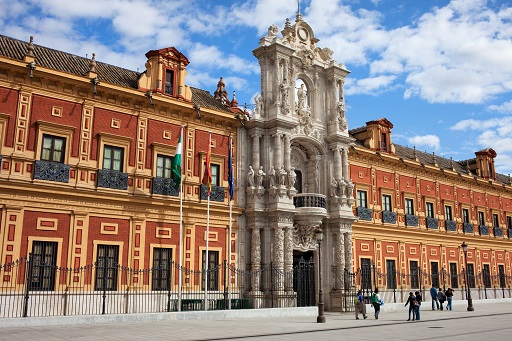
San Telmo Palace
The Palacio de San Telmo is the seat of the Presidency of the Junta de Andalucía. It is a baroque building located in Seville and built between the seventeenth and eighteenth centuries to be the headquarters of a college of sailors.
Direction: C / Palos de la Frontera, 41004 Sevilla
Schedule: Monday to Friday of 9.00 a 19.00 h - other days closed
Phone: 955001010
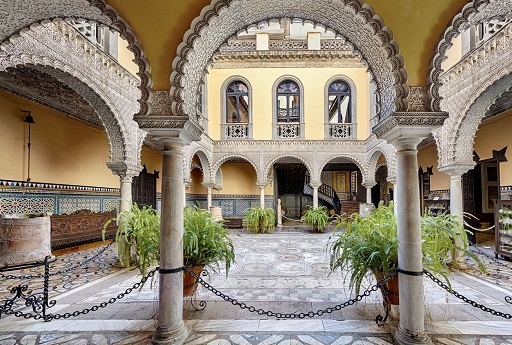
Palace of the Countess of Lebrija
The Palace of the Countess of Lebrija or Palace of Lebrija, In sevilla, it is located on one of the busiest streets in the city center, Cuna street, parallel to the famous Sierpes street. It dates from the 16th century and the most characteristic is the impressive collection of Roman mosaics, that pave practically the entire ground floor, so it is considered the “best paved palace house in Europe”. The palace, in addition to being open to the public as a museum since 1999, rents its rooms and patios for presentations, incentives, gala dinners, conferences, concerts, among others.
Direction: C/Cuna 8, 41004 Sevilla
Schedule: Monday to Sunday from 10.30 a 19.30 h
Phone: 954227802
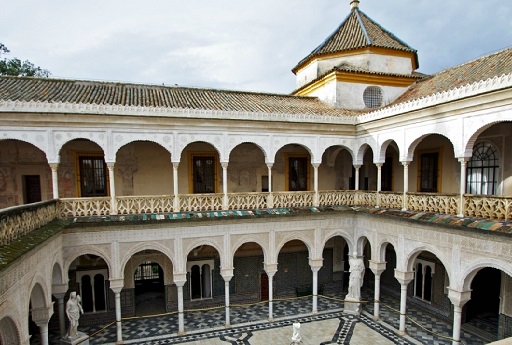
Pilate's House
The Casa de Pilatos is a palace belonging to the Casa de Medinaceli. It is one of the most emblematic buildings of 16th century Andalusian civil architecture and presents a combination of Italian Renaissance and Spanish Mudejar styles..
Direction: Pilatos Square 1, 41003 Sevilla
Schedule: Monday of 9.00 a 19.00 h, Tuesday to Sunday from 9.00 a 18.00 h.
Phone: 954225298
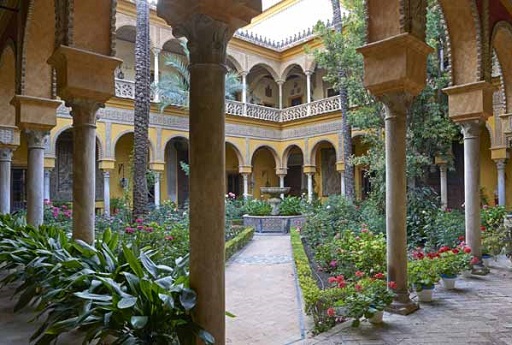
Palace of Las Dueñas
The Palacio de las Dueñas is a building that belongs to the Casa de Alba. It was built in the 15th century and renovated in Gothic-Mudejar and Renaissance styles.. Your visit is highly recommended as it houses a large collection of paintings, sculpture and decorative arts from the 16th to 20th centuries and for their historical and artistic value, It was declared an Asset of Cultural Interest in 1931., what's more, the poet Antonio Machado was born in 1875.
Direction: C / Dueñas 5, 41003 Sevilla
Schedule: Monday to Sunday from 10.00 a 17.15 h.
Phone: 954214828
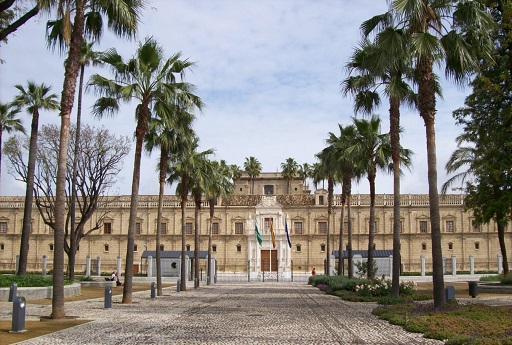
Ancien Hospital of Las Cinco Llagas – Parlamento de Andalucía
The old hospital of the Five Wounds of Our Redeemer, also know as blood hospital, It is a building that is located in the Macarena neighborhood of Seville and that currently constitutes the seat of the Parliament of Andalusia.
Direction: Parlamento de Andalucía, 41009 Sevilla
Schedule: Monday to Sunday from 8.00 a 22.00 h.
Phone: 954595929

Royal Tobacco Factory – Current University of Seville
The Royal Tobacco Factory in Seville was the headquarters of the first tobacco factory established in Europe and is the most important industrial building in Spain from the 18th century. It has the qualification of Asset of Cultural Interest since 1959, with the category of Historical Monument. Since the mid-twentieth century, it has housed the headquarters of the Rector's Office of the University of Seville and some of its faculties.
Direction: C / San Fernando 4, 41004 Sevilla
Schedule: Monday to thursday